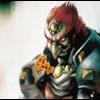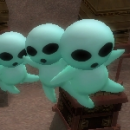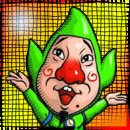Just like the hat doesn't have an origin in TMC? o:
It does, Ezlo created it. Symbolism.
So is it a coincidence that all heroes wear the same tunic that the Kokiri-raised Link happens to receive?
Call it coincidence or call it destiny. In reality it's Nintendo keeping true to Link's original character design.
OoT describes it as a one-size fits all tunic, actually.
Show me the quote.
Regardless of all, mistaking Link's clothes for those that a fairy wears is crazy.
Now you're just being crazy.
How so?
And how come you avoid addressing the other half of my points?
I rather them just separate the 3D games from the 2D games and call it a different legend.
Nah, I wouldn't go so far as to disconnect that timeline entirely from the other games (that is, from TMC and a quasi-OoT). I don't want to tear the games apart completely, the triple prong is fine with me.
Oocca could easily precede the Wind Tribe (they certainly precede OoT), or the Wind Tribe could be on another timeline.
Did you notice how the Wind People basically come off like predecessors of the Hylians, wielding advanced technology like their robots (Armos, Eyegores, Mazaal)? Their relationship with deceased King Gustaf supports it, especially as depicted in the TMC manga. All that heavily reminds me of the sky people in TP.
The Oocca are clearly not the Wind Tribe, however.
Directy they aren't, no. But the name Oocca isn't in the original game, it just talks about the sky people. "Sky people" may refer to the Oocca as well as to potential humans who used to live with them in ancient (TMC) times.
To associate the Oocca with the birds we see in the Wind People's house is not that big of a stretch then.
Well, I'd like to hear everyone's thoughts on these matters.
Let me do so by commenting on the other members' replies:
- Since ALttP uses the war to explain the background for the Imprisoning War, so it gives details relevant to the start of the Imprisoning War, but leaves out its conclusion.
- Since OoT uses the war to explain how Link came to the woods, it gives few details as to the war's cause, but tells us about its end.
- Since TP uses the war to explain the history of the Twili and Light Spirits, it gives no details beyond the war's cause and the role of these two groups.
That I call a perfect summary!^^
These could even be related to the backstory of TMC, although I don't really think that follows, since the existence of TMC before OoT would interrupt what should have been a period of greed and hatred. I also unite them with FSA, with TP expanding on the dark tribe legend.
However, I'm more than willing to consider the possibility that the latter two: the civil war prior to OoT and the one that led to the banishment of the Twili's ancestors, may be one and the same.
The only reason I divide them, is [...] because Lanayru seems to suggest that this war occurred very early in time, when people first lost their innocence (which they had since the creation of the world... with the greed for the Triforce being the proverbial fruit of knowledge).
Because of this, I think it fits better before (or coincidentally with) the backstory of MC (the monsters could have been used by the Twili ancestors, just like Ganondorf usually does... but that's justa crazy idea).
There's nothing in TMC (or before) that made the people lose their innocence. And likewise, the period of greed didn't begin until well after TMC.
A horde of ghosts haunting Hyrule is no problem, that wasn't the people's fault.
Vaati usurping Hyrule's throne for a short while isn't worthy to be mentioned by Lanayru either (not that it affects TP's plot anyway).
And very conveniently, the Triforce is not yet a topic of public interest throughout TMC (although its symbol is already used to represent Hyrule because the royal family possibly knows).
Given that, TMC fits perfectly as the first game before OoT, and well before the mages conflict happens. If you put that conflict before TMC, I think you do have to worry about Lanayru sounding like he gets the facts wrong.
In the beginning, the people heard of the Sacred Realm and began to quarrel over the location. A tribe of magic users becomes the dominant group, in which fighting them most of the Sheikahs are lost, until the Light Spirits seal them away. Before or after this, the invasion of monsters is halted by the Hero of Men. Soon after, the fighting dies down and the King unifies the country. This sounds like a bloody history of Hyrule to me.
MC-OOT-MM-Ganondorf's attack-TP all follow.
Hmm.. Leave the Hero of Men out of the mages conflict, and you're good to go. Your summary tries to combine what Serkol and Lex said, but how would you cram TMC so closely between the fierce war and OoT?
In conclusion, I believe that all of the wars mentioned in the games are one single war occurring before OOT, and the fighting mentioned in ALTTP is separate, which lead into the IW since during that time Ganondorf found the entrance. So in my theory there were on two periods of struggle.
That explanation is justified, and it works for you. I'll stick to uniting all three wars though because it also works.^^
Also, I am not sure when to place the Oocca helping the Hylian and putting them as leading race in Hyrule within all this. Clearly, if we assume a pre-OoT placement of MC, this would have to be before that game... but in either case, how does the banishment of the Twili's ancestor relate to the Oocca? Did that war happen before they helped establish the Hylian kingdom? Or After?
I solve this question based on my previous decision to put the mages war after TMC. So the Sky People weren't affected by the war, but the Hylian King may have tried to seek help from them, via the messengers to the skies. Maybe, if the Sky People really were closer to the Gods than the Hylians, couldn't it be that they appealed for some divine assistance in the stead of Hyrule's people, thus causing the Light Spirits to intervene in the war?
Some speculate a connection between the Twili and the Sheikah (because TP confirms that the Sheikah dwindled in numbers after some wars) and the Sheikah do have a connection with the Oocca. Should that be of any indication? Or be dismissed entirely?
It is implied by the charas in TP that the Sheikahs' disappearance triggered the loss of contact to the Sky People. But it makes no real difference whether that was due to the Sheikah dying in the fight with the mages, or due to the Sheikah being banished because they actually
were the mages.
This topic is great, because for a long time I've wanted to post a really lengthy translation of *everything* that Impal says in TP. I think there are one or two things of interest in there, so check it out when I soon post it over in the translation thread (and to debate it, return here).


















